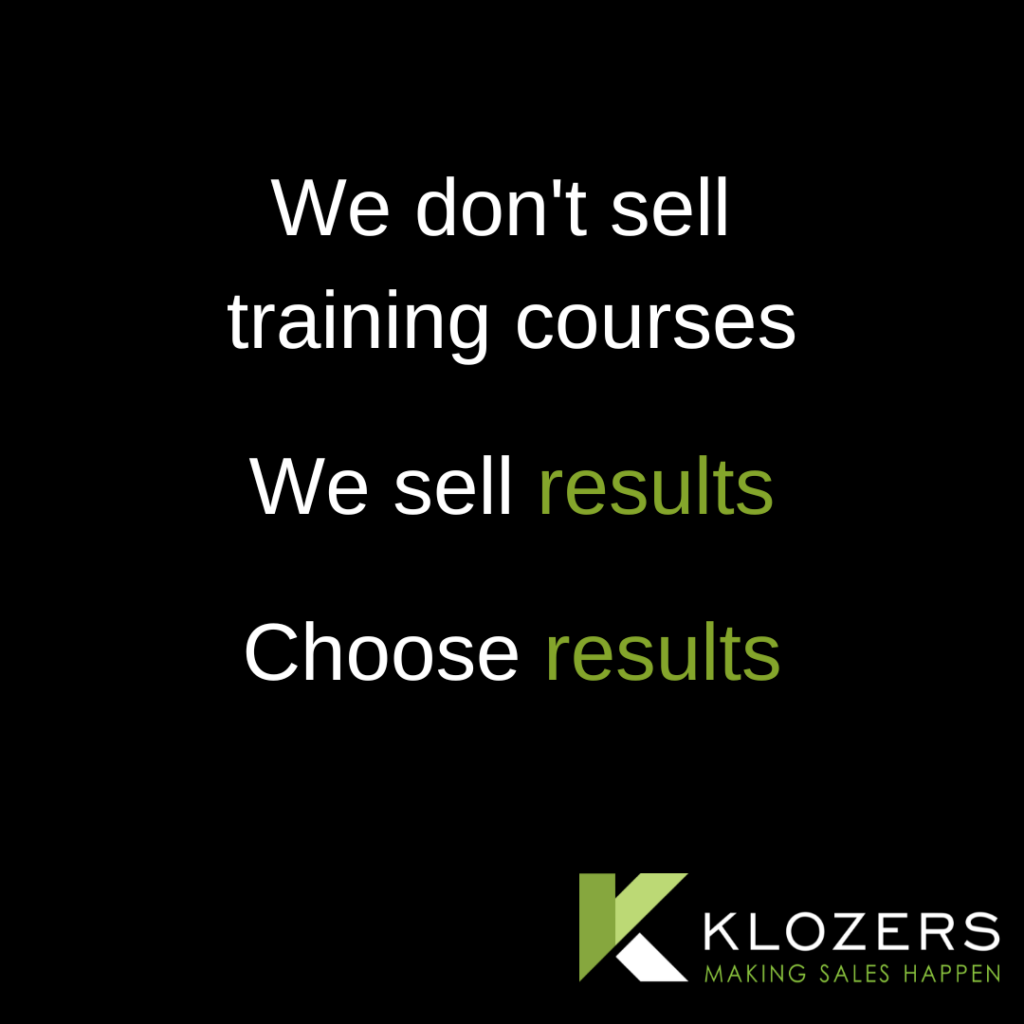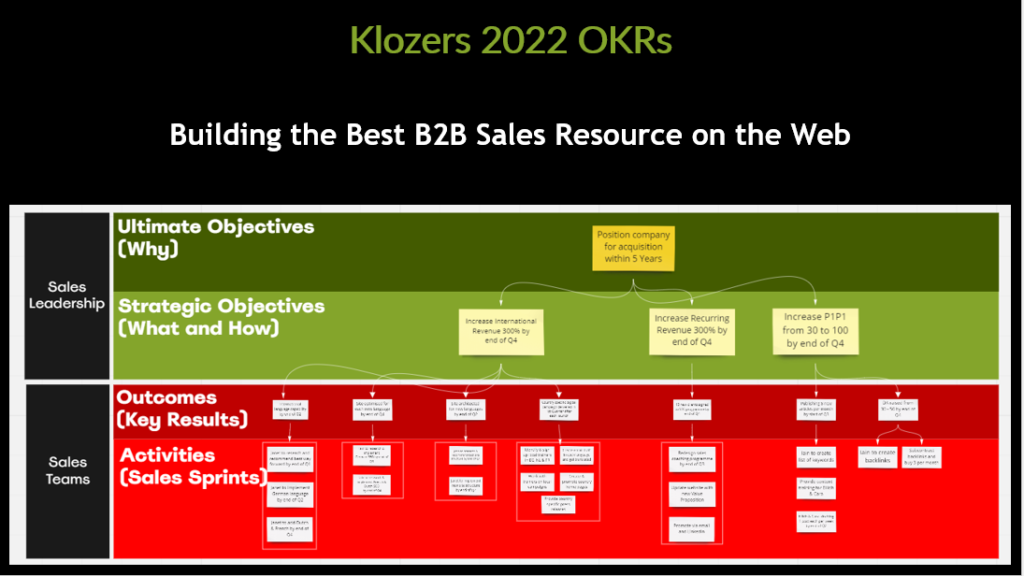
Sales Team OKRs | Achieving Sales Goals with OKRs
Sales Team OKRs - Top Question from Google
Are OKRs good for Sales?
OKRs (Objectives, Key Results) are good for sales because they help with engagement, productivity and ensure that the sales teams activities are aligned, and delivering against the company’s growth strategy. Sales OKRs are not an alternative to KPIs and actually work alongside KPIs to improve your sales.
In this article we will cover...
“The most useful and best days training I’ve ever had. Love your style.”
Gary CEO
1. Our OKR Journey
As a company we must confess that we have been slow to move away from our traditional Balanced Scorecard based approach to management. We fell foul of the old adage “if it ain’t broke don’t fix it”. Our Scorecards were ruthlessly simple and served us well for many years as we continued to customise and fine tune them to our business.
Our belief that because we were using and tracking our most important KPIs led us to ignore the OKR methodology, when in reality they are very different and each bring different value to sales and business management.
Our driver for change came from the need to help our clients with managing their sales teams, many of whom were SaaS or IT based business. Our clients were already using the OKR methodology and applying it to their sales function was easier than introducing our previous scorecard approach.
As a company one of our key differentiators has always been that we only teach sales strategies and tactics that we use in our own business. So, in mid-2021 we dropped our traditional scorecards and moved over to the OKR methodology.
They say everything in life has a purpose and timing wise our move to OKRs could not have been better. Since rebuilding the business after our traditional face to face training and coaching business was wiped out by the lockdowns, we have had a huge focus on growth.
Without a doubt, our OKRs have helped us with strategizing, planning and then executing. This resulted in a record turnover for 2021 and an amazing start to FY 2022.
I’ve shared some of our own Objectives and Key Results as examples later in this article for those who would like some more detail. But first…
2. How are OKRs different from KPIs?
Many companies use sales KPIs which is great and we would encourage you to continue doing so. This is because OKRs and KPIs are very different and perform different “roles” within your sales management function.
The primary role of sales KPIs are to measure Performance and or Quality. In the world of sales we have lots of KPIs such as Cost of Customer Acquisition, Churn, Sales Conversion Ratios in fact the list goes on and on. In our experience there is often too much time creating reports full of KPIs that no one has the time to read or action. Over reporting is definitely a problem you should be aware of.
So, to summarize KPIs measure performance and quality in the BAU (Business as Usual) activities of sales. As a simple example, if your sales reps are making out bound sales calls then your KPIs might look something like this:
Number of dials made – Performance KPI
Conversion ratio of dials to demos – Quality KPI
OKRs on the other hand are very different, bigger and more encompassing. But despite this, OKRs are a really simple process to implement and follow. Here’s our definition of OKRs:
Objectives are inspiring BAG goals (Big Audacious Goals). These Objectives typically come from either strategy implementation, change in direction that the company has chosen, an improvement that may have been highlighted by your KPIs, or some form of innovation. Please read on for some examples of each.
OKRs are your driving force for change, improvement & innovation.
Once these Objectives have been chosen you then decide which Key Results would indicate that you were either progressing or had achieved your Objective. You can include sales KPIs in your Key Results as a measurement.

3. How do I Set up OKRs
There are many books and teachings around the Objectives and Key Results methodology and implementation which we would encourage you to read. Our system may be slightly different to those as we have customised them to the world of sales, so feel free to refine our process to your own business. With that said the process we use works and will work in your business as is.
3.1 Start with your ultimate objective
This is your purpose, your why, the reason you exist. In the majority of cases this has already been defined in your Business Plan. Therefore, as long as your purpose and why is still relevant then this should be a very quick exercise.
It’s worth pointing out that no sales rep is motivated by things like increasing profit margins, market share or your exit strategy. Therefore it’s important that your Ultimate Objective resonates with everyone in the sales team, not just the shareholders.

3.2 Next identify your Strategic Sales objectives
These should come from your sales strategy and by achieving these you would have achieved or at least be making progress towards the Ultimate Objective that you have defined. For teams new to Objectives and Key Results, and those with limited resources chose a maximum of three strategic sales objectives.
In terms of implementation wherever possible these objectives should be exiting and motivating to the sales team. Buy in and engagement are key to your success so it’s important that the sales team feel motivated to achieve the objectives.
With our own clients we encourage the leadership team to choose 5 strategic objectives and then ask the sales teams to choose three. By simply including and allowing them a say in the objectives helps dramatically with engagement and performance, when the hard work starts.
With your Strategic Sales objectives it’s important to think big hence we use the phrase BAG Goals – Big Ambitious Goals. Whilst the big goals may seem unattainable and in reality it may even turn out to be unattainable, studies show that most companies achieve 70-80% of their Objectives. Achieving 70-80% of a Big Ambitious Goal delivers much more impact than 100% of a regular goal.
In terms of the time frame, the Ultimate Objective would be at the least an annual goal but more likely a 3 -5 year goal. The Strategic Objectives would be at least a quarterly (three month) goal with larger annual goals for example broken down into quarterly milestones.
Another important consideration is which are of the sales the objectives are. What we mean by this is that every sales team regardless of what they sell has four core areas they need to focus on. We call these the high value areas of sales and they are Finding, Closing, Growing & Developing.
When you focus your time and energy exclusively on finding, closing and growing sales, it’s almost impossible not to sell more. Developing is the continued personal and professional development of the team.
In an ideal world you would pick one objectives that directly correlated with either Finding, Closing and Growing. Circumstances may dictate you need to focus on one are which is fine but we would advise against having all three objectives in the one area of sales.
Your Strategic Sales Objectives need to excite, inspire and motivate the sales team. As always, we strongly recommend running personal goal setting sessions and linking the Reps personal goals to the business goals.

3.3 Identify your key results
With your sales team first identify the key results that would indicate progress towards or attainment of your sales objective. The Key Results should be as specific and detailed as possible, and also be timebound.
When defining the Key Results it’s important to understand and include the Lead Indicators and not just the Lag Indicators. Lead Indicators are the KPIs recording the activities and actions that lead to the results.
Here’s an example a client set an Ultimate Objective of creating a new recurring revenue stream. The WHY behind this was to help balance the peaks and troughs in their Business as Usual sales.
They then decided on a Strategic Sales Objective of increasing the LTV (Life Time Value) by 50% by end of Q3. They set themselves three Key Results as follows:
* Increase their Customer Satisfaction Score to 7 by end of Q2
* Increase the number of annual contracts they sold to Enterprise Accounts by end of Q2
* Upsell 15% of users from their Base subscription to the Premium
From these Key results the Team collectively decided what activities they would need to undertake in order to attain the Key Results. (There were many more activities required than this, but we have abbreviated)

The answer to these questions can be used to create a series of milestones within your plan that would be used to track progress to the original Key Results.
Now we have defined our objectives and key results that last step is to create our Sales Sprints and define the activities within the sprints. These are the activities that the sales reps need to undertake in order to achieve the Key Results.
It’s worth reiterating that the earlier and greater involvement that the sales reps have in the design and planning the more engaged they will be. Simply throwing a list of Activities at Reps and dressing it up as a Sprint won’t work.
At this stage it would not be unusual for the Sprint activities to include actions and input from other departments. For OKRs focussed on finding new prospects you may require input from marketing to work alongside the SDRs and create a new sales campaign. Including marketing and indeed any other department is the first step to fully aligning your sales and marketing functions which is always positive.
4. Sales OKR Examples
As previously mentioned, one of the reasons our clients love our Sales Training is how we only train our clients on the same sales strategies and tactics that we use in our own business. We test and prove everything before we include it in any of our training.
The slide below shows our own Sales OKR examples that as a team we are working towards through the year. Not all our Strategic Objectives are on track and some are ahead and we are happy to share what’s working and what’s not.
Here’s a brief summary to help you understand:
Strategic Sales Objective 1
Increase International revenues 300% by end of Q4 – we are currently behind on this but our pipeline suggest we can still achieve this. I think we underestimated how much work was involved in getting set up for this, however, despite being behind this is really exciting.
Strategic Sales Objective 2
Increase Monthly Recurring Revenue 300% by end of Q4 – we are on target for this OKR which is great. With that said, in retrospect we perhaps were not ambitious enough when setting the original Objectives. By achieving this Objective we have now increased our Customer Lifetime Value which helps with our gross profit margin. Lots of wins with this particular goal.
Strategic Sales Objective 3
Increase P1P1 from 30 – 100 by end of Q4 – P1P1 refers to the number of keywords we have at Position 1 on Page 1 of Google which drives our Inbound Lead Generation. The Goal was to increase the number from 30 to 100 and considering we have over 250 keywords on Page 1 itself we thought this was achievable. This has however, proven to be much more difficult than we though and we currently only have 48 Keywords at Position 1. This means it’s taken 7 months to add 18 keywords to the top of Google and we need another 52 in the remaining 5 months. That is still a huge achievement and we still have a little over a Quarter to go so fingers crossed we can make up some ground.
Other Sales OKR examples we have supported our clients with are:
Sales Cycle – reducing the sales cycle which came from a Business Objective which was to improve cashflow in the organisation. Using the sales analytics from withing the clients CRM we undertook a thorough sales pipeline analysis to understand which deals where lagging, why they were lagging and what remedial action could be taken. Reducing the sales cycle was one of a number of activities that contributed to this.
Sales Process – most companies either lack a formal sales process or they have a sales process but their salespeople struggle to follow the sales process consistently. Improvements in sales process re typically linked to KPIs around sales performance.
Quarterly Revenue – as you would expect many companies are keen to drive growth and quarterly revenue is a common OKR that we encounter.
Monthly Recurring Revenue – monthly recurring revenue or MRR whilst predominantly associated with SaaS businesses, is a good indicator for every business that measures the sales from existing customers.
Channel Partners – channel partner development is common for those looking to scale quickly and profitably. Channel Partners, strategic partnerships and affiliate programmes are fast, low cost and proven routes to market.

5. Where does Sales Training Fit in the OKR system?
Sales Training is very different to most business training in that sales results are dependant on so many variables it can be difficult to prove a connection between the training and the new revenue.
Furthermore, without the input and support of the Sales Leadership Team training is often left without reinforcement, resulting in salespeople, resorting to the original behaviours prior to the training starting. It’s a vicious circle.
In addition, many of the issues around sales and growth revolve around these challenges:
- How do we align the day to day sales activities with the companies overall sales growth strategy?
How do we keep the Sales People focused on the right type of sales activities and hold them accountable to these activities?
How do we provide an objective way to measure the sales performance and activities of our sales people?
How do we align the remuneration of sales people with the right sales activities that support our sales strategy?
How do we provide an objective way to report sales performance so we can identify skills gaps within sales management and the sales team?
Fortunately the OKR system answers all of these questions and more.
Whether using our own system or that of our clients we work with the Sales Manager to provide weekly sales reports, update sales targets, refine the overall sales approach, analyse lost deals and ensure the sales efforts of each team member are aligned with the sales OKRs.
Our OKR based Sales Team Coaching program provides training as and when required by the Sales Sprints. This ensures that we are providing training and coaching that has a direct correlation to the clients Sales Objectives.
The training therefore is highly targeted, customised and relevant to the participants. This is why our clients get genuine sales success and grow sales consistently.
The most common training and coaching we provide is currently around customer engagement which includes supporting every Team Member with their sales pitch as part of their overall sales approach, sales pipeline analysis, pipeline coaching, individual sales targets – behavioural and commercial.
6. How do I run the Sales Sprints?
Just to recap Sales Sprints are the activities that the sales team choose to undertake in order to achieve the Key Results that signal the Sales Objectives have been met.

There are many experts on Lean, Agile, Scrums, Sprints and Kanban each of which is designed for developers. Sales and Salespeople are slightly different and we have adapted the original Lean methodology to suit the needs and circumstances of our clients.
Here’s some guidance notes based on our experience:
5.1 The sales leaders must include the sales team early in the planning process to get buy in.
5.2 Invest time early on to run a personal goal setting session and then link the personal and business goals.
5.3 Train and Coach the Team Leaders and Managers hard as they are the glue that holds everything together.
5.4 Implement monthly 121’s with the sales managers and the sales team.
5.5 Never force training on the salespeople. Those who don’t want to learn, won’t. As frustrating as it sounds, these people need to be allowed to fail before they can overcome their own ego.
5.6 Every project has ups and downs. The downs are where the deep learning starts and where the biggest gains are to be made.
We run monthly sprints each of which lasts for 3 weeks. This allows the teams a breather from the intensity of the Sprints, for the last calendar week of the month yet maintains the momentum in the Sprint. If training is required our preference is to deliver this during the first two weeks of the Sprints which ensures the team can spend the later half of the month focussing on the Sprint and their Business As Usual activities ie; closing deals.
“A fantastic learning experience”
Amanda – Account Manager
Share this page

Author Bio
Iain Swanston has spent over 30 years in B2B sales selling, training and leading teams both domestically and internationally. In addition he serves as an Associate at Strathclyde University Business School where he has delivered the sales content for the Masters in Entrepreneurship since 2015.
Related Posts
124 City Road,
London,
EC1V 2NX.
8911 North Capital of Texas Highway, Suite 4200 #1154
Austin, TX 78759
United States
Klozers
Ground Floor
470 St Kilda Road
Melbourne VIC
3004


